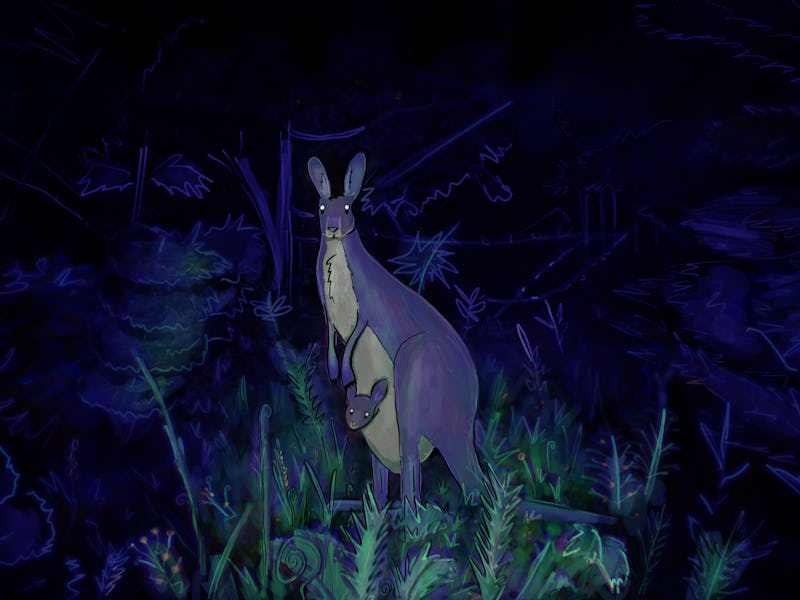Animal Well might be brilliant, but I don’t know if I’ll ever see why. The first game from developer Billy Basso and YouTuber Dunkey’s Bigmode label, Animal Well was released on May 9 to a tidal wave of positive reviews praising its multi-layered puzzles and the inventive spin it puts on the Metroidvania subgenre. But while it’s clearly charmed most of its early players, I’ve found it a drag to actually get through.
At the outset, Animal Well is totally opaque. You play as a tiny blob — like Kirby with the cuteness dial turned down — dropped into the titular well full of animals. On your map are four flames, which you presumably need to reach. Everything else is up to you.
Animal Well is a gorgeous, puzzle-filled adventure that I just couldn’t connect with.
I thought I was ready to see what lay at the end of the journey. I generally like games that encourage experimentation and demand that players find unorthodox solutions to problems for themselves. I’m also a fan of Metroidvanias, so Animal Well’s exploration-focused puzzle solving called to me. But I quickly found myself running in circles thanks to a design that seems to prize obfuscation above all other concerns and my desire to uncover its deeply buried secrets was soon replaced with annoyance.
The first and biggest obstacle I ran into was just getting around. That’s a big concern in any Metroidvania, where learning to traverse environments is a skill that only comes from experimentation and the slow accumulation of new abilities. But in Animal Well, movement is pretty simplistic. Traversal isn’t really fun for its own sake — it’s just getting you from point A to point B, and I found getting there more tedious than enjoyable. Early environments are filled with basic jumping puzzles that are more a test of patience than platforming, and single rooms often demand you maneuver through a maze of platforms or use a tool that creates floating footholds to slowly scale cliffs.
Animal Well’s environments are packed with secrets — and, predictable, animals.
No game is going to be a joy to navigate 100 percent of the time, but in Animal Well, constant backtracking means that any room you find it irritating to move through will come back to haunt you over and over. There are plenty of spots in the game where missing a single jump can send you plummeting multiple screens down, forcing you to find your way back just to try again, which wouldn’t be such a big deal if it weren’t for the tedium of navigation. Even if you ace every jump and don’t have the same problem, Animal Well’s design encourages constant backtracking and scouring every corner of the map for secrets. Like it or not, you’re going to spend a lot of time following the same path through the same environments over and over.
All this is made more frustrating by a pretty inadequate map. Each room is represented by a tiny, even more pixelated version of how it appears in the world, with enough information to see doors and ladders but often not enough to make out anything else. Even though the map offers a lot more detail than a lot of games do, I still found myself lost more than I have been in a game in quite some time.
Individual rooms in Animal Well are often exquisitely crafted, with secrets hiding in the environment art and hidden passages leading to treasure, but I could never fix the game’s overall layout in my mind. While I can still run through huge swaths of Hollow Knight or other similarly structured games in my memory, Animal Well feels like a series of arbitrarily connected rooms in a way that makes it hard to map even in the middle of playing. Whenever I found a new item and knew just where to use it or had a eureka moment about a puzzle I’d abandoned earlier, I inevitably spent more time finding my way back than I did actually executing the solution.
Animal Well’s obtuseness kept me from digging deeper into its mysteries.
Animal Well’s puzzles are largely built on experimenting with your limited tool set and find clever ways to combine multiple items. There’s plenty of joy in seeing an unexpected solution bear fruit, but its trial-and-error formula gets stale quickly. As much fun as it is to come up with a new way to use a tool then finding that it actually works, what happened more frequently in my playthrough was that I’d simply throw enough firecrackers, frisbees, and yo-yos (some of your earliest tools) at a problem that eventually one ended up being the key. As a result, the satisfaction of finding a creative answer to a tough puzzle that so many other players seem to have experienced felt to me more like a tepid, “Oh, I guess that’s what I was supposed to do.”
That’s how I feel about the game overall as well. While every room is packed with its own secrets, they don’t seem to cohere into anything larger — or if they do, it’s after you’ve already beaten the game and spent dozens of hours searching the map for secrets you missed along the way. I felt no sense of momentum playing Animal Well, as everything I did felt disconnected from the rest, without a sense that it was building to anything comprehensible.
To give credit where credit is due, Animal Well is an astonishingly pretty game full of creative ideas in both its presentation and its approach to puzzles. Even reaching the game’s ending credits is just scratching its surface, and the deeper mysteries hidden within still call to me despite my frustration with its base mechanics. But in the end, those base mechanics make up how you spend your time in a game, and they soured my experience enough that I’m fine leaving the mysteries at Animal Well’s heart unsolved.
